-
ORIGINAL ARTICLE12-16-2024
Childbirth care by health professionals: conflicting practices in obstetrics
Revista Brasileira de Enfermagem. 2024;77(6):e20230129
Abstract
ORIGINAL ARTICLEChildbirth care by health professionals: conflicting practices in obstetrics
Revista Brasileira de Enfermagem. 2024;77(6):e20230129
DOI 10.1590/0034-7167-2023-0129
Views0See moreABSTRACT
Objectives:
to understand the perceptions of women and health professionals regarding childbirth care at a teaching hospital in the western state of Paraná, Brazil.
Methods:
this qualitative study employed Grounded Theory, conducted in an obstetric care service with 38 participants (women and health professionals) through semi-structured interviews.
Results:
limitations in physical infrastructure and management of care, along with the women’s limited knowledge about the childbirth process and the decision-making and guidance of professionals, show conflicting obstetric practices-a discrepancy between good practices and obstetric violence. Training in obstetric nursing and active participation in care, alongside the presence of a companion, were identified as intervening conditions and strategies in the process.
Final Considerations:
childbirth care is characterized by dichotomous practices. While some professionals base their practices on scientific evidence, others rely on teachings and experiences from the time of their training.
-
12-16-2024
Religión y experiencia profesional: ¿Serán predictores de la inteligencia espiritual de los enfermeros? Estudio transversal
Revista Brasileira de Enfermagem. 2024;77(6):e20240217
Abstract
Religión y experiencia profesional: ¿Serán predictores de la inteligencia espiritual de los enfermeros? Estudio transversal
Revista Brasileira de Enfermagem. 2024;77(6):e20240217
DOI 10.1590/0034-7167-2024-0217es
Views1See moreRESUMEN
Objetivos:
analizar la relación entre religión y experiencia profesional con la inteligencia espiritual en enfermeros.
Métodos:
estudio transversal y analítico realizado en 2021, participaron 544 profesionales de enfermería que laboraban en establecimiento de salud de Perú durante la pandemia por COVID-19. Para el análisis de los datos se emplearon el análisis de regresión múltiple y correlación de Pearson.
Resultados:
en los enfermeros predominó un nivel de inteligencia espiritual saludable (42,8%). Quienes no profesaban una religión tenían mayor probabilidad de tener menor puntaje de inteligencia espiritual (escala global y dimensiones); sin embargo, los enfermeros expertos tuvieron mayor probabilidad de tener mayor inteligencia espiritual (escala global y dimensiones) que los enfermeros novatos (p<0,05).
Conclusiones:
la inteligencia espiritual en los enfermeros fue predicha por la religión y la experiencia profesional. Este hallazgo sugiere que la inteligencia espiritual en enfermería se consolida mediante prácticas religiosas y durante el ejercicio profesional.
-
12-16-2024
A relação entre gênero, formação educacional e ambiente de aprendizagem com a ansiedade do estudante de enfermagem
Revista Brasileira de Enfermagem. 2024;77(6):e20220615
Abstract
A relação entre gênero, formação educacional e ambiente de aprendizagem com a ansiedade do estudante de enfermagem
Revista Brasileira de Enfermagem. 2024;77(6):e20220615
DOI 10.1590/0034-7167-2022-0615
Views1See moreRESUMEN
Objetivos:
identificar las variables asociadas a la práctica clínica relacionadas con la ansiedad de los estudiantes de enfermería.
Métodos:
se utilizó un diseño descriptivo, cuantitativo, correlacional con las recomendaciones STROBE, EQUATOR. La población fue de 233 estudiantes de enfermería con una muestra de 135 personas. Los datos se recopilaron de marzo a abril de 2022 utilizando instrumentos validados.
Resultados:
la prueba de chi-cuadrado y razón de verosimilitud significativa para género, formación académica y entorno de aprendizaje son superiores a 0.05, por lo que no existe una relación significativa entre las variables y la ansiedad de los estudiantes.
Conclusiones:
los estudiantes necesitan prepararse nuevamente antes de ingresar al campo de la práctica. Investigaciones cualitativas también son necesarias.
-
ORIGINAL ARTICLE12-16-2024
Bladder ultrasound: evidence of content validity of a checklist for training nurses
Revista Brasileira de Enfermagem. 2024;77(6):e20230183
Abstract
ORIGINAL ARTICLEBladder ultrasound: evidence of content validity of a checklist for training nurses
Revista Brasileira de Enfermagem. 2024;77(6):e20230183
DOI 10.1590/0034-7167-2023-0183
Views0See moreABSTRACT
Objectives:
to develop and analyze evidence of content validity of a checklist for training nurses in measuring bladder volume through ultrasound.
Methods:
a methodological study, consisting of three stages: literature review; instrument item preparation; and analysis of evidence of content validity. The Content Validity Index (CVI) and Gwet’s AC2 were used for content validity analyses.
Results:
the checklist consisted of 23 items. The CVIs for clarity, relevance and dimensionality were 0.99, 0.99 and 0.98 respectively, and the CVIs for Gwet’s AC2 with coefficients for clarity, relevance and dimensionality were 0.89, 0.97 and 0.95, respectively, with p<0.001.
Conclusions:
the checklist developed for training nurses in measuring bladder volume through ultrasound achieved adequate evidence of content validity, and can be used to train nurses in clinical practice and future research.
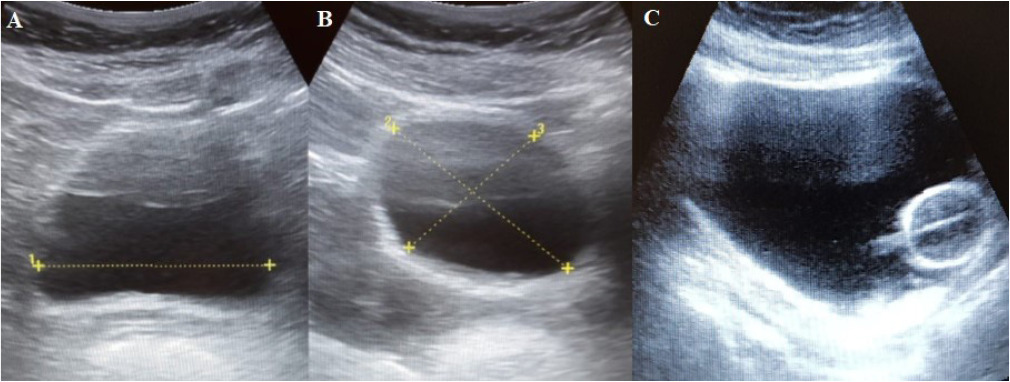
-
ORIGINAL ARTICLE12-16-2024
Nursing team’s perceptions about care for pregnant women in a psychiatric unit
Revista Brasileira de Enfermagem. 2024;77(6):e20230186
Abstract
ORIGINAL ARTICLENursing team’s perceptions about care for pregnant women in a psychiatric unit
Revista Brasileira de Enfermagem. 2024;77(6):e20230186
DOI 10.1590/0034-7167-2023-0186
Views0See moreABSTRACT
Objectives:
to understand the nursing team’s perception in relation to the care provided to pregnant women with mental disorders admitted to a psychiatric hospital unit.
Methods:
Convergent Care Research carried out between August and December 2021, through semi-structured interviews with 25 nursing professionals from a Psychiatric Unit from a reference Hospital in Southern Brazil.
Results:
the organized and analyzed data resulted in two thematic categories: Technical, generic and impersonal care; and From impersonality to the singularity of nursing care. Ensuring unique care for pregnant women with mental disorders means giving them a meaning of existence and providing care from a multidimensional and continuous perspective.
Final Considerations:
nursing care for pregnant women in psychiatric hospitalization requires continuous professional qualification, interactive technologies and support for the nursing process, in addition to promoting singular and multidimensional care.
-
ORIGINAL ARTICLE12-16-2024
The nursing practice environment and hospital sociotechnical complexity: a mixed-methods study
Revista Brasileira de Enfermagem. 2024;77(6):e20230315
Abstract
ORIGINAL ARTICLEThe nursing practice environment and hospital sociotechnical complexity: a mixed-methods study
Revista Brasileira de Enfermagem. 2024;77(6):e20230315
DOI 10.1590/0034-7167-2023-0315
Views1See moreABSTRACT
Objectives:
to analyze the relationship between the nursing practice environment and hospital sociotechnical complexity as perceived by nurses.
Methods:
a sequential explanatory mixed-methods study was conducted in a hospital in southern Brazil. The Brazilian version of the Practice Environment Scale-Nursing Work Index and the Complexity Characterization Questionnaire were administered to 132 nurses. Subsequently, semi-structured interviews were conducted with 18 participants, and the data were subjected to thematic analysis. Data integration was achieved through a connection approach.
Results:
the nursing practice environment was found to be favorable, except in the subscale concerning Staffing and Resource Adequacy, where complexity was present in the activities. The three emerging categories explained human and technical aspects related to complexity in the practice environment, quality of care, and patient safety. Unexpected variability was inversely correlated with the practice environment.
Conclusions:
the study results indicate a relationship between these constructs, with implications for the quality and the safety of care.
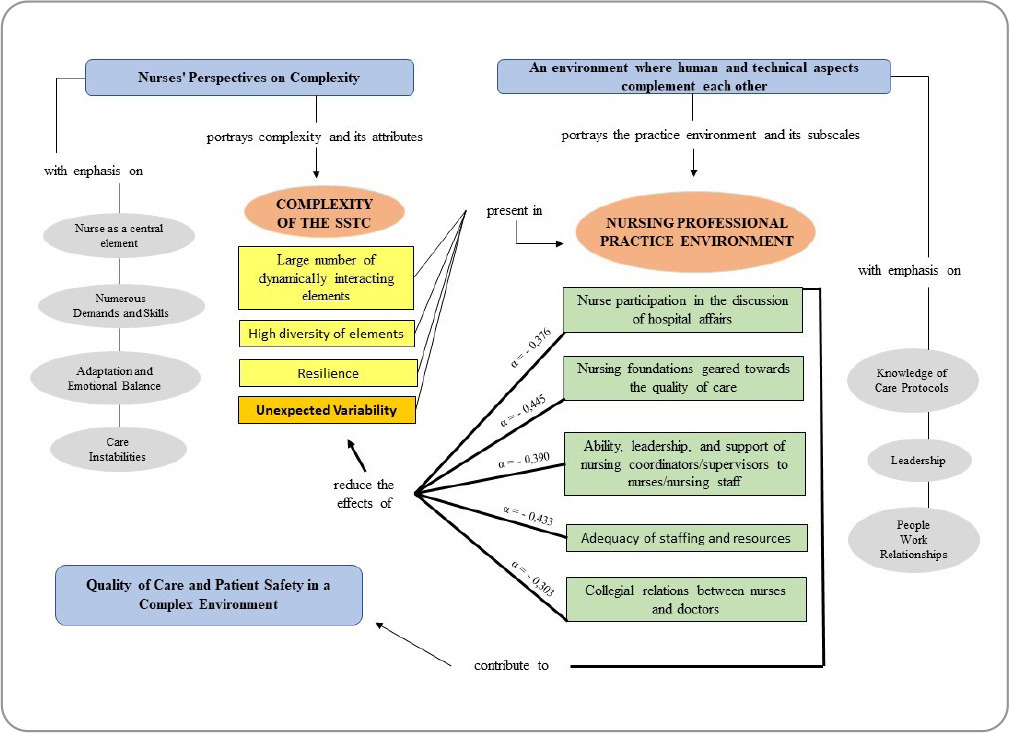
-
ORIGINAL ARTICLE12-16-2024
Factors associated with maternal well-being during childbirth among postpartum women in Minas Gerais
Revista Brasileira de Enfermagem. 2024;77(6):e20230304
Abstract
ORIGINAL ARTICLEFactors associated with maternal well-being during childbirth among postpartum women in Minas Gerais
Revista Brasileira de Enfermagem. 2024;77(6):e20230304
DOI 10.1590/0034-7167-2023-0304
Views0See moreABSTRACT
Objectives:
to analyze the factors associated with maternal well-being during childbirth among postpartum women in Minas Gerais.
Methods:
a cross-sectional study nested within a cohort was conducted with postpartum women in a municipality of Minas Gerais. The Maternal Well-being in Childbirth Scale 2 was used. The prevalence of maternal well-being during childbirth was estimated. The magnitude of the association between maternal distress and care practices was estimated using the Prevalence Ratio (PR), applying Poisson regression.
Results:
a total of 183 postpartum women aged between 15 and 46 years participated, with 26.2%, 27.9%, and 45.9% reporting excellent, adequate, and poor well-being during childbirth care, respectively. Maternal distress was more prevalent among women who underwent cesarean sections (PR = 1.60) and those who did not receive breastfeeding information (PR = 1.59).
Conclusions:
a high prevalence of maternal distress during childbirth was observed, associated with cesarean delivery and the lack of breastfeeding information.
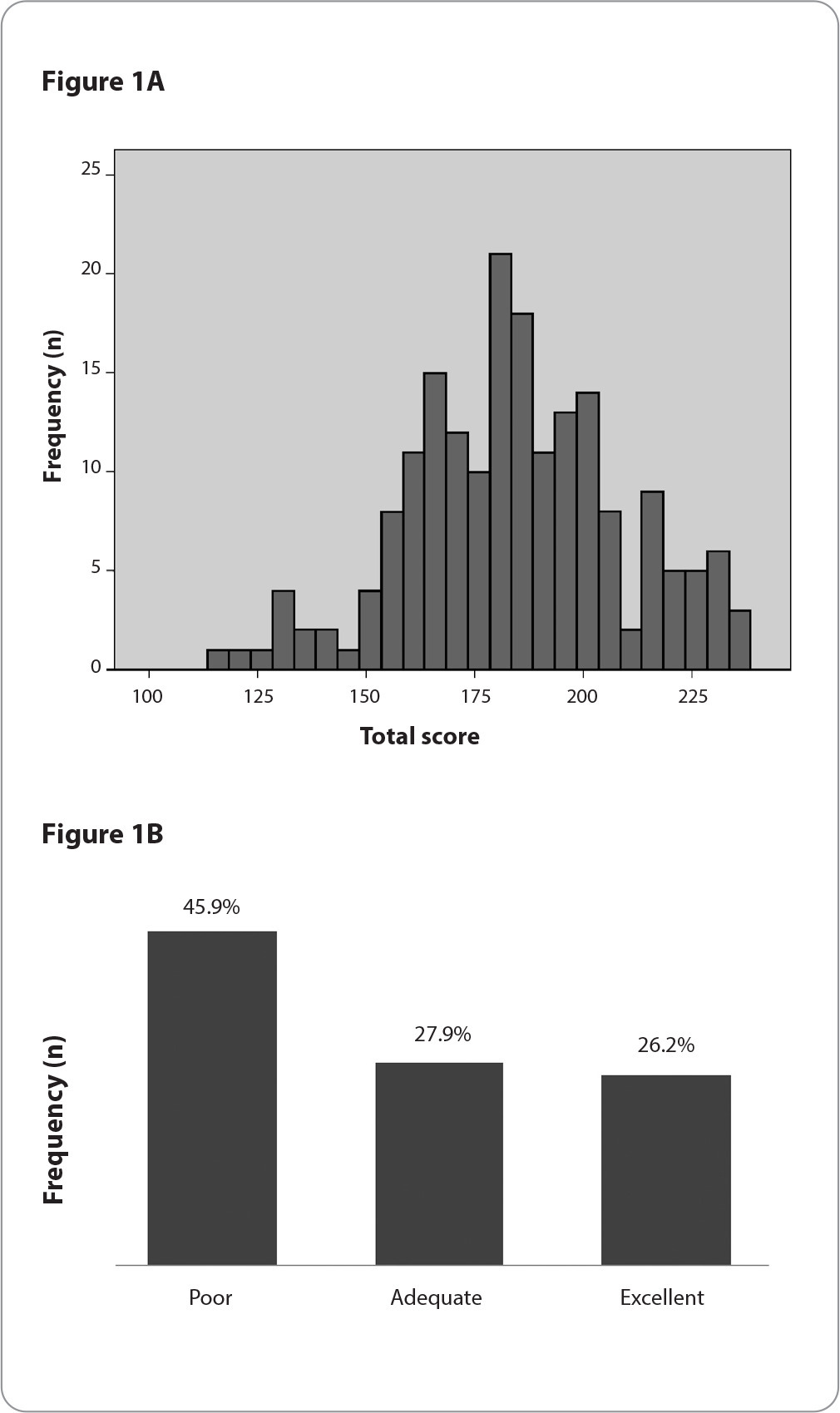
-
ORIGINAL ARTICLE12-16-2024
Prevalence and factors associated with musculoskeletal pain among hospital cleaning staff
Revista Brasileira de Enfermagem. 2024;77(6):e20230237
Abstract
ORIGINAL ARTICLEPrevalence and factors associated with musculoskeletal pain among hospital cleaning staff
Revista Brasileira de Enfermagem. 2024;77(6):e20230237
DOI 10.1590/0034-7167-2023-0237
Views0See moreRESUMO
Objetivos:
verificar a prevalência e os fatores associados à dor musculoesquelética em trabalhadores do serviço hospitalar de limpeza.
Métodos:
estudo transversal, realizado com trabalhadores de limpeza de um hospital de ensino do Sul do Brasil. Utilizaram-se questionário com variáveis sociodemográficas, laborais e de saúde, o Nordic Musculoskeletal Questionnaire e o Diagrama de Corlett e Manenica. Realizou-se análise bivariada.
Resultados:
participaram 149 trabalhadores. Prevaleceu dor musculoesquelética na coluna lombar no último ano (65,8%) e últimos sete dias (42,3%). Constataram-se associações entre automedicação e dor na parte inferior das costas (p=0,020) e ombros (p=0,026); sedentarismo, oito horas de sono diárias e dor nos tornozelos (p=0,041) e pés (p=0,039); ex-tabagismo, uso de medicamento e dor nos punhos (p=0,015) e mãos (p=0,004).
Conclusões:
prevaleceram lombalgias associadas a hábitos de saúde e vida. Um programa de educação em saúde e recomendações de melhorias nos processos de trabalho podem minimizar a exposição à dor musculoesquelética.
-
ORIGINAL ARTICLE06-17-2020
Implementation of improvement cycle in health records of mobile emergency prehospital care
Revista Brasileira de Enfermagem. 2020;73(4):e20190049
Abstract
ORIGINAL ARTICLEImplementation of improvement cycle in health records of mobile emergency prehospital care
Revista Brasileira de Enfermagem. 2020;73(4):e20190049
DOI 10.1590/0034-7167-2019-0049
Views0See moreABSTRACT
Objective:
to evaluate the effect of the implementation of a quality improvement cycle in the completion of occurrence forms of a Mobile Emergency Service.
Methods:
this is a time series, quantitative, quasi-experimental study without control group, with three quality assessments in which was used an improvement cycle for adequacy of health records in Mobile Emergency Service Patos.
Results:
in 100% of the seven criteria, there was improvement between evaluations. Noncompliance with criteria reduced from 95 cases in the first evaluation to eight cases in the third evaluation.
Conclusions:
the representation of joint results between the three evaluations highlighted progressive improvement in the compliance with each criterion.

-
ORIGINAL ARTICLE09-21-2020
Stigma perceived by overweight women
Revista Brasileira de Enfermagem. 2020;73:e20190321
Abstract
ORIGINAL ARTICLEStigma perceived by overweight women
Revista Brasileira de Enfermagem. 2020;73:e20190321
DOI 10.1590/0034-7167-2019-0321
Views0See moreABSTRACT
Objective:
to understand the experience of discrimination perceived by overweight women.
Methods:
a qualitative research conducted at an outpatient clinic in Salvador, Bahia, where eleven women were interviewed. The interviews were transcribed and submitted to thematic content analysis.
Results:
the analysis of the statements expressed three categories: Suffering discrimination in different social contexts: denounced disrespect, hostility, veiled and/or explicit exclusion, prejudice, injustice and insults lived in public transport, at work, in the family environment, in social events and commercial establishments; Experiencing negative feelings about discrimination: revealed inferiority, sadness, shame, fear, anger, frustration, low esteem and discouragement faced by women; Reacting to discrimination: expressed isolation of marital intimacy and social encounters, removal from work, concealment of body and feelings and even illness of women.
Final considerations:
the discrimination experienced in various settings has caused suffering, embarrassment, negative feelings, shame, isolation and loss in women’s lives.
-
ORIGINAL ARTICLE09-19-2022
The experience of trans or transvestite women in accessing public health services
Revista Brasileira de Enfermagem. 2022;75:e20210713
Abstract
ORIGINAL ARTICLEThe experience of trans or transvestite women in accessing public health services
Revista Brasileira de Enfermagem. 2022;75:e20210713
DOI 10.1590/0034-7167-2021-0713
Views0See moreABSTRACT
Objective:
to understand the meanings of being a trans or transvestite woman in the care provided by Unified Health System health professionals.
Methods:
qualitative research, guided by Heidegger’s phenomenology, with 10 trans or transvestitewomen residing and using the Unified Health System in a municipality in Minas Gerais. Fieldwork was carried out by interviews.
Results:
trans or transvestitewomen reproduce the social patterns constructed and accepted by the female, with the search for hormonization being common, and, when it is difficult to obtain a prescription, they resort to self-medication. Social name use and acceptance by health professionals promote recognition. Trans or transvestitewomen experience prejudice on a daily basis, not only by professionals, but also because of the assumption of diagnoses by other users.
Final considerations:
transphobia promotes withdrawal from health services, due to fear, shame, knowledge about professionals’ unpreparedness, triggering illness, social exclusion and violence.
-
ORIGINAL ARTICLE06-10-2022
Effects of the economic recession on suicide mortality in Brazil: interrupted time series analysis
Revista Brasileira de Enfermagem. 2022;75:e20210778
Abstract
ORIGINAL ARTICLEEffects of the economic recession on suicide mortality in Brazil: interrupted time series analysis
Revista Brasileira de Enfermagem. 2022;75:e20210778
DOI 10.1590/0034-7167-2021-0778
Views0See moreABSTRACT
Objectives:
to analyze trends in suicide rates in Brazil in the period before and after the start of the economic recession.
Methods:
interrupted time series research using national suicide data recorded in the period between 2012 and 2017 with socioeconomic subgroups analyses. Quasi-Poisson regression model was employed to analyze trends in seasonally adjusted data.
Results:
there was an abrupt increase in the risk of suicide after economic recession in the population with less education (12.5%; RR = 1.125; 95%CI: 1.027; 1.232) and in the South Region (17.7%; 1.044; 1.328). After an abrupt reduction, there was a progressive increase in risk for the black and brown population and for those with higher education. In most other population strata, there was a progressive increase in the risk of suicide.
Conclusions:
the Brazilian economic recession caused different effects on suicide rates, considering social strata, which requires health strategies and policies that are sensitive to the most vulnerable populations.
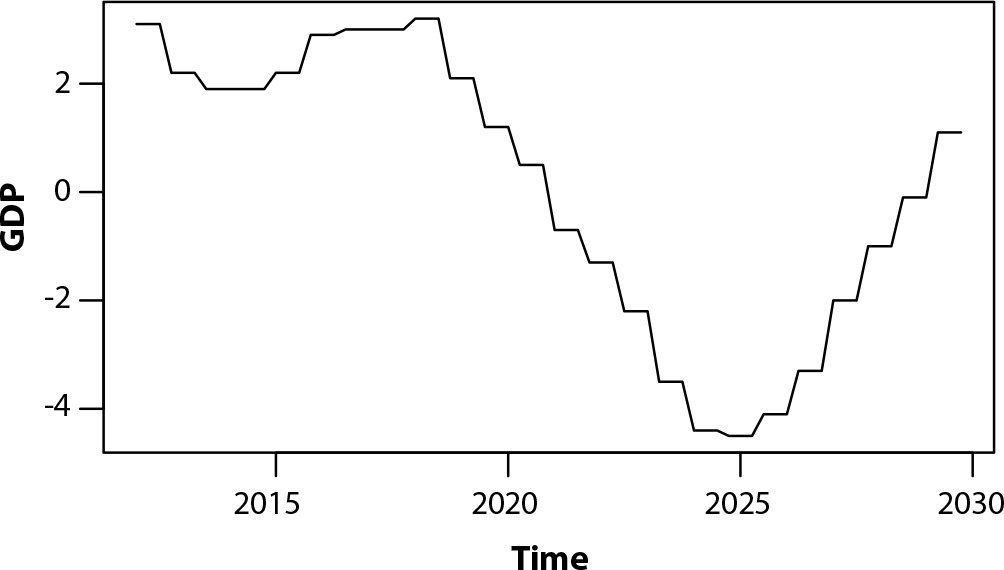
-
REVIEW05-21-2021
Evaluation strategies in active learning in higher education in health: integrative review
Revista Brasileira de Enfermagem. 2021;74(2):e20201055
Abstract
REVIEWEvaluation strategies in active learning in higher education in health: integrative review
Revista Brasileira de Enfermagem. 2021;74(2):e20201055
DOI 10.1590/0034-7167-2020-1055
Views0See moreABSTRACT
Objectives:
to analyze scientific evidence on evaluation strategies for active learning methods in health undergraduate programs.
Methods:
integrative literature review in the Medical Literature Analysis and Retrieval System Online, Latin American and Caribbean Literature in Health Sciences, Nursing Database, Scopus, Web of Science and Education Resources Information Center databases.
Results:
different evaluation strategies are used: Presentation of seminars, Self-evaluation, Evaluation of student performance in Tutotest-Lite tutoring, Peer Evaluation, Active Learning and Critical Thinking Self-evaluation Scale, Objective and Structured Clinical Exam, Portfolio, Progressive Disclosure Questions, Modified Dissertation Questions, Progression Test, Dissertation Test, Objective Test, Immediate Learning Checks, Clinical Case Resolution and Cumulative Test.
Final Considerations:
evaluation strategies in active learning are used in combination, aiming at the affective, cognitive and psychomotor development of the student. However, studies with greater power of scientific evidence would be needed.
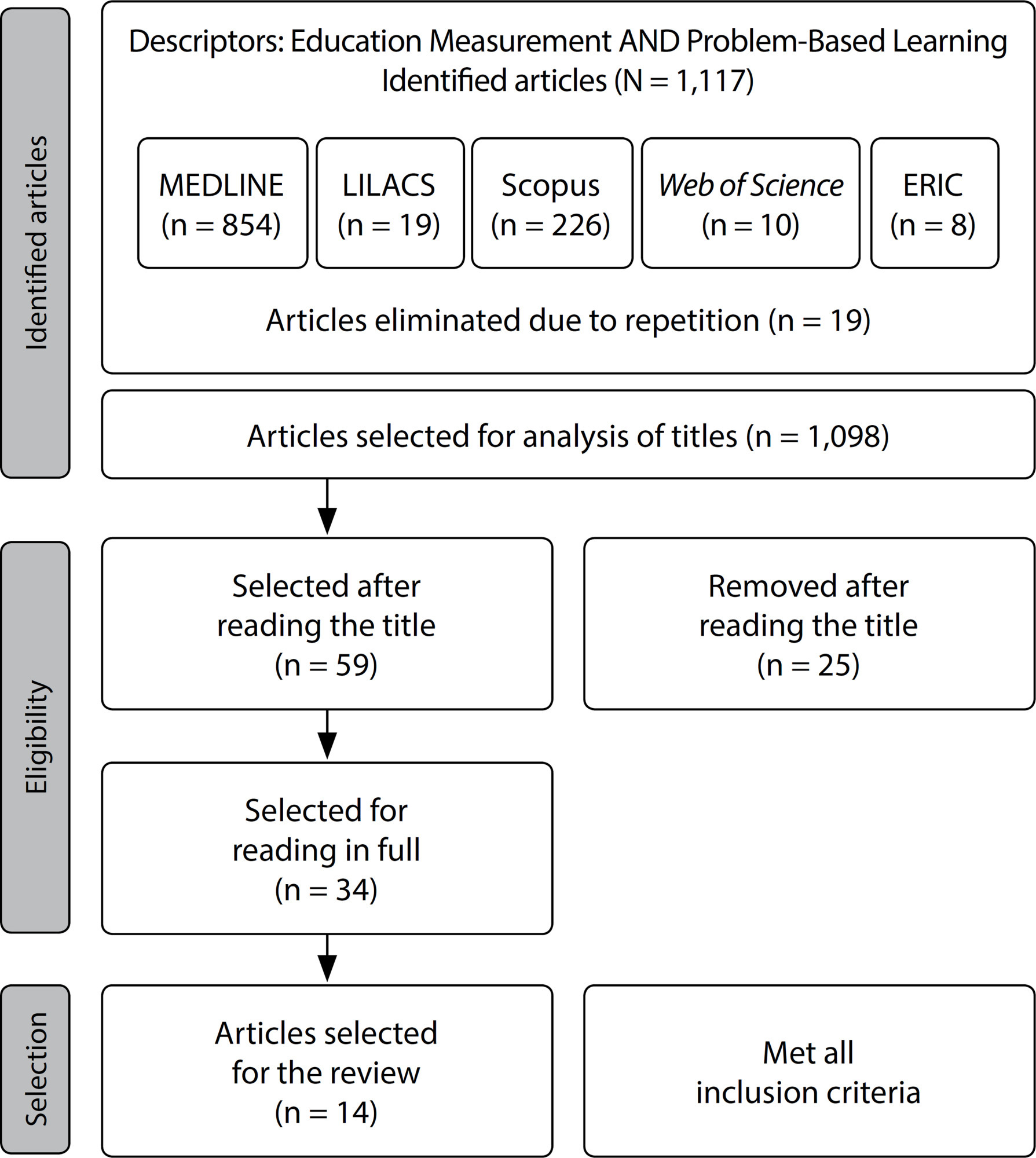
-
ORIGINAL ARTICLE12-05-2019
Participation in university activities for the elderly: Motivations of Brazilian and Spanish Seniors
Revista Brasileira de Enfermagem. 2019;72:104-110
Abstract
ORIGINAL ARTICLEParticipation in university activities for the elderly: Motivations of Brazilian and Spanish Seniors
Revista Brasileira de Enfermagem. 2019;72:104-110
DOI 10.1590/0034-7167-2018-0181
Views0See moreABSTRACT
Objective:
To understand the reasons that lead Brazilian and Spanish seniors to enroll in a university for the elderly.
Method:
A qualitative study that used Symbolic Interactionism as a theoretical reference and the Grounded Theory as a methodological reference. We interviewed 44 seniors enrolled in universities for the elderly from two countries (Brazil and Spain) between October 2014 and May 2016.
Results:
The motivations were related to the necessity of occupying the free time, even for improving health; to the opportunity of access to university learning bypassing formal education criteria; to the expansion of social relations, sought through the creation of new friendships, the desire to know other people’s life experiences, and the exchange of knowledge.
Final considerations:
Older people have sought in universities for the elderly a pleasurable way of learning and occupying the free time.
-
ORIGINAL ARTICLE08-10-2020
Knowledge, applicability and importance attributed by nursing undergraduates to communicative strategies
Revista Brasileira de Enfermagem. 2020;73(6):e20190411
Abstract
ORIGINAL ARTICLEKnowledge, applicability and importance attributed by nursing undergraduates to communicative strategies
Revista Brasileira de Enfermagem. 2020;73(6):e20190411
DOI 10.1590/0034-7167-2019-0411
Views0See moreABSTRACT
Objectives:
To evaluate the knowledge, applicability and importance that nursing students attribute to therapeutic communicative strategies.
Methods:
This is a quantitative study (survey) with nursing undergraduates from a public institution. The online questionnaire by the SurveyMonkey tool, comprising the informed consent form and six questions, had its relevance, clarity and operability assessed by experts.
Results:
Of the 104 graduates, 50 participated in the study; the most well-known and applied strategy was Therapeutic Communication, followed by Ask-Tell-Ask, NURSE and Tell Me More; the least were PACIENTE and SPIKES. Most use the strategies they know best; all were considered important by at least 82% of the students.
Conclusions:
The partial knowledge and application of these strategies by the students contributes to reflect on the complexity of their teaching-learning process.
-
ORIGINAL ARTICLE05-28-2021
The work of a Brazilian nursing team of collective health in the special indigenous health district
Revista Brasileira de Enfermagem. 2021;74(2):e20200116
Abstract
ORIGINAL ARTICLEThe work of a Brazilian nursing team of collective health in the special indigenous health district
Revista Brasileira de Enfermagem. 2021;74(2):e20200116
DOI 10.1590/0034-7167-2020-0116
Views0See moreABSTRACT
Objective:
To identify the potential and the limits of the actions of the nursing team in the Primary Health Care for the Health of the Indigenous.
Methods:
This is a quantitative study guided by the Theory of Practical Intervention of Nursing and Collective Health. 230 nursing professionals participated, responding to an instrument about the frequency of the actions carried out in assistance, management, teaching, and research.
Results:
168 nursing technicians and 62 nurses participated. As strengths, 80% participated in the assistance most of the time. Stand out: 90.3% and 71% of nurses carried out nursing consultations and house visits, respectively. As a limitation, the involvement in education and research is small. Only 2% of the interviewees carried out scientific researches, reflecting the need to broaden and qualify care and improve the use of traditional practices, overcoming the biomedical model.
Final considerations:
Nursing assistance is essential in the modification and monitoring of the epidemiological profile of indigenous populations, and its results allow for the planning of quality actions.

Search
Search in:
Nuvem de Tags
Adolescente (85) Atenção Primária à Saúde (239) COVID-19 (91) Criança (91) Cuidados de Enfermagem (269) Educação em Enfermagem (151) Educação em Saúde (139) Enfermagem (930) Enfermagem Pediátrica (86) Estudantes de Enfermagem (77) Estudos de Validação (131) Família (87) Idoso (208) Promoção da Saúde (99) Qualidade de Vida (104) Saúde do Trabalhador (86) Saúde Mental (145) Saúde Pública (82) Segurança do Paciente (150) Tecnologia Educacional (100)



